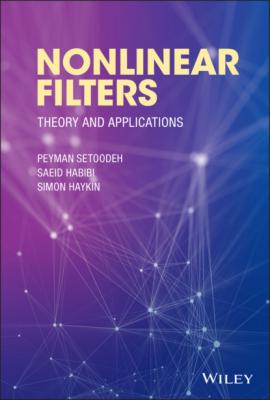Nonlinear Filters. Simon Haykin
Чтение книги онлайн.
Читать онлайн книгу Nonlinear Filters - Simon Haykin страница 10
 alt="bold u element-of double-struck upper R Superscript n Super Subscript u"/>, represents the effect of the external events on the system, and its output, denoted by
alt="bold u element-of double-struck upper R Superscript n Super Subscript u"/>, represents the effect of the external events on the system, and its output, denoted by A state‐space model includes the corresponding mappings from input to state and from state to output. This model also describes evolution of the system's state over time [12]. In other words, any state‐space model has three constituents [8]:
A prior, , which is associated with the initial state .
A state‐transition function, .
An observation function, .
For controlled systems, the state‐transition function depends on control inputs as well. To be able to model active perception (sensing), the observation function must be allowed to depend on inputs too.
The state‐space representation is based on the assumption that the model is a first‐order Markov process, which means that value of the state vector at cycle
(2.1)
It should be noted that if a model is not a first‐order Markov process, it would be possible to build a corresponding first‐order Markov model based on an augmented state vector, which includes the state vector at current cycle as well as the state vectors in previous cycles. The order of the Markov process determines that the state vectors from how many previous cycles must be included in the augmented state vector. For instance, if the system is an
(2.2)
Moreover, if model parameters are time‐varying, they can be treated as random variables by including them in the augmented state vector as well.
2.3 The Concept of Observability
Observability and controllability are two basic properties of dynamic systems. These two concepts were first introduced by Kalman in 1960 for analyzing control systems based on linear state‐space models [1]. While observability is concerned with how the state vector influences the output vector, controllability is concerned with how the input vector influences the state vector. If a state has no effect on the output, it is unobservable; otherwise, it is observable. To be more precise, starting from an unobservable initial state
Definition 2.1 (State observability) A dynamic system is state observable if for any time , the initial state can be uniquely determined from the time history of the input and the output for ; otherwise, the system is unobservable.
Unlike linear systems, there is not a universal definition for observability of nonlinear systems. Hence, different definitions have been proposed in the literature, which take two questions into consideration:
How to check the observability of a nonlinear system?
How to design an observer for such a system?
While for linear systems, observability is a global property, for nonlinear systems, observability is usually studied locally [9].
Definition 2.2 (State detectability) If all unstable modes of a system are observable, then the system is state detectable.
A system with undetectable modes is said to have hidden unstable modes [16, 17]. Sections provide observability tests for different classes of systems, whether they be linear or nonlinear, continuous‐time or discrete‐time.
2.4 Observability of Linear Time‐Invariant Systems
If the system matrices in the state‐space model of a linear system are constant, then, the model represents a linear time‐invariant (LTI) system.
2.4.1 Continuous‐Time LTI Systems
The state‐space model of a continuous‐time LTI system is represented by the following algebraic and differential equations: